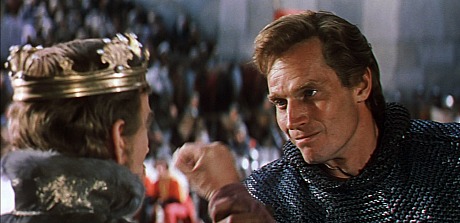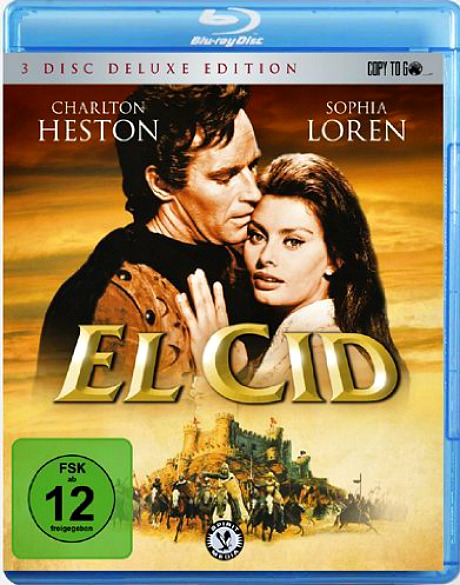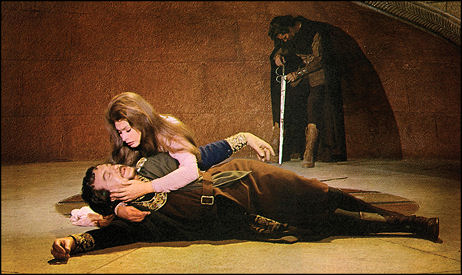I don’t know why I’ve never bought the 2009 German Bluray of Anthony Mann‘s El Cid (’61), but I finally did this morning — $20something including shipping. An August ’09 DVD Beaver review says that the Koch Media Bluray (a) delivers essentially the same package contained in the January 2008 Miriam (i.e., Miramax) two-disc DVD, (b) reps an improvement over the DVD version but (c) could look better.”
And that was by 2009 standards. Seven years have passed, 4K renderings are commonplace and an early ’60s large-format film looking pretty good no longer cuts the mustard.

If Universal can pop for luscious 4K remasterings of Spartacus and One-Eyed Jacks, somebody should stand up and create a 4K-scanned domestic Bluray of El Cid. Martin Scorsese pushed for a restoration of this 1961 costumer way back in ’93, and yet nothing has resulted on these shores aside from the 480p Miriam two-disc DVD, which popped in January 2008.
El Cid needs a domestic 4K rebirth. Like Spartacus, El Cid was shot in 35mm 8-perf Technirama. The materials were upgraded to 70mm for roadshow engagements. A quality-level remastering would look like $100 million bucks. If it were my call I would get restoration guru Robert Harris, who delivered that immaculate Spartacus restoration Bluray along with the Godfather restorations of a few years back, to do the job. Who better?
I’m told that El Cid was shot on Eastman 5250 or 5251, and that the materials shouldn’t have significant fade issues.
Scorsese’s Film Foundation partnered with Uni on the One-Eyed Jacks restoration. A proper El Cid Bluray seems like a natural for the Film Foundation, especially given Scorsese’s ardent support for restoring this historical epic 23 years ago.

And this time there will be no arguments about aspect ratios. El Cid is squarely and fundamentally a 2.35 anamorphic animal. Yes, it was printed “up” when converted to 70mm but…I don’t really know what I’m talking about. But I’m guessing that the original 35mm Technirama photography delivered a 2.35 image and that the 70mm 2.21:1 roadshow prints were slightly cropped on the sides.
Here’s an mp3 of Milos Rosza’s main title music.
John Evan Frook‘s 1993 Variety story about the initial plan for an El Cid restoration delivers a slight head-scratcher.
Frook reports that while the original general release version of El Cid ran 180 minutes, “Miramax plans to add 16 minutes of restored footage.” Except the 2008 Miriam DVD ran 181 minutes, according to Amazon, while the German Koch Media Bluray runs 188 minutes. I can’t find a record of a 196-minute version anywhere. I’m guessing that Frook got it wrong.
From a 2009 HE assessment: “Directed by Anthony Mann and starring Charlton Heston, Sophia Loren, Raf Vallone and Herbert Lom, El Cid is a dramatically respectable film with a still-interesting subtext — a battle between valiant Christians and marauding, wild-eyed Moors. A little stiff, a little too stately for its own good…but that was the style of the day.

The somewhat despised Criterion laserdisc of El Cid
“I’ve always liked the first half (i.e., the part mainly concerned with love and honor — Heston’s personal issues and his hunger for Loren’s Jimena) better than the second half in which Heston wears a beard and struts around like a great God-like figure. The highlight of Part 1 is a pretty good jousting-and-sword fight sequence in an arena.
“The single best element in the whole film, if you ask me, is Miklos Rosza’s score.”
Jimena: Why did you come?
El Cid: I tried not to come. I tried, I told my love it had no right to live. But my love won’t die…
Jimena: Kill it.
El Cid: You kill it! Tell me you don’t love me.
Jimena: [long pause] I cannot. Not yet. But I will make myself worthy of you Rodrigo,. I will learn to hate you.
Heston didn’t have much affection for Loren during filming (and vice versa), and one result of this discomfort (according to a female eyewitness who was around during the shoot) is that during their scenes together Heston avoided eye contact with Loren, at least now and then. Once you’ve heard this, the watching of El Cid takes on an extra layer of humor and intrigue. Heston does look away from her a lot.
Why the animus? Heston tended to be “a little rough” on his female costars at the time, but he also (a) resented Loren’s pizza breath (i.e., a result of her eating Italian dishes between takes and not enough subsequent tooth-brushing and mouthwashing) and (b) the fact that Loren was paid the then-astronomical sum of $1 million by El Cid producer Samuel Bronston.

From Dave Kehr’s N.Y. Times review of the 2008 Miriam DVD:
“In ‘The Red and the Blacklist: The Intimate Memoir of a Hollywood Expatriate,’ Norma Barzman, Ben Barzman’s widow, writes that Samuel Bronston had been able to finance his Spanish operations thanks to an arrangement with the DuPont family, who wanted to sell oil to Spain under Franco but did not want to be paid in unexportable Spanish pesetas. Instead the DuPonts plowed their local profits into Mr. Bronston’s films, which could then be sold around the world for more convertible currencies.
“As Mr. Bronston’s biographer, Neal M. Rosendorf, and son, Bill Bronston, note on the commentary track, the film draws flattering parallels between Heston’s medieval hero and Franco, whose government was in on the oil deal. The dastardly Moors, led by a coal-eyed, black-robed Herbert Lom, became stand-ins for the Communists, whom Franco had crushed in the Civil War. And in the cold war context of 1961, such foes were still perceived as enough of a clear and present danger to make Franco a prized American ally.
“To top it off, Mr. Bronston (born Bronstein) was related to Leon Trotsky (born Lev Davidovich Bronstein), a relationship that could hardly have thrilled Franco.
“Surely setting some kind of record for the number of strange bedfellows packed into a single cot, El Cid ought to have been either an extremely lively, contentious film or a total smoking train wreck. Oddly enough, it is neither, but rather a handsome, rather placid, perfectly professional production.”












